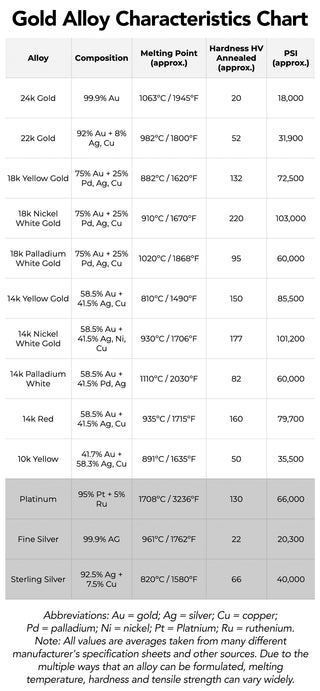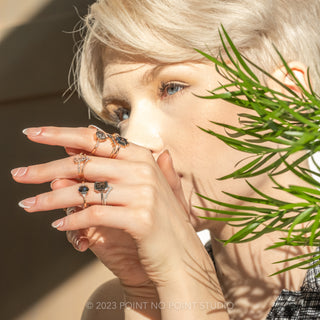
About our materials
At Point No Point Studio, we redefine diamonds with our distinctive touch. Our designs showcase the beauty of natural, extraordinary salt and pepper diamonds and captivating black and white diamonds. We take pride in crafting unique engagement, wedding, and commitment rings that seamlessly blend modern aesthetics with timeless elegance.
Conflict Free Diamonds
Each of our designs feature conflict free diamonds. We have worked for years to develop relationships with dealers that source only conflict free diamonds from countries that adhere to the Kimberely Process Certificate process.
The Kimberley Process unites administrations, civil societies, and industry in reducing the flow of conflict diamonds - rough diamonds used to finance wars against governments' around the world.
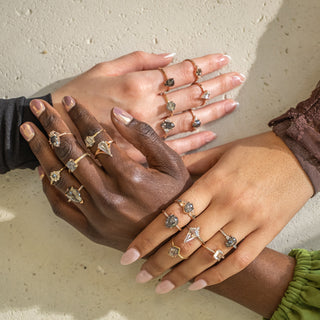
Eco Friendly Metals
Our unwavering commitment to the environment ensures that each piece is made with eco-friendly gold and platinum. Eco friendly gold and platinum is the same molecular composition as non-recycled gold and platinum. It is just much better for the environment because 100% of the gold and platinum is from non-newly mined sources. Mining of precious metals is very impactful on the environment. Sadly, there is a huge market for illegally mined gold from sensitive areas of the world like tropical rainforests. It is impossible to trace or test gold from its origin so determining illegally mined gold is impossible when sold on the open market. Illegal miners will clear cut huge areas of the rainforest to mine gold. Deforestation is only one of the consequences of illegally mined gold. Illegal miners use mercury to separate gold from ore then burn it off. The excess mercury leaches into the water table and into drinking water, lakes, rivers and into the air poisoning native populations and animals. For those seeking a custom, heirloom-worthy engagement ring that defies convention and supports the environment, Point No Point Studio is your perfect match.

Here at Point No Point Studio, we are committed to responsibly and sustainably sourcing our materials. We are a proud Harmony Authorized Partner; our jewelry is crafted exclusively using 100% recycled metals. Every piece is hallmarked with a purity stamp.

As a Harmony Authorized Partner, all of our jewelry is created using 100% recycled metals. Our material supplier, Hoover & Strong, is audited each year by SCS Global Services and have always passed SCS’s strict sustainability guidelines to ensure our materials are 100% environmentally and ethically responsible. Recycled gold and sterling silver are the same color and molecular composition as non-recycled metals. The raw metal has been refined from non-mined sources such as reclaimed jewelry, silverware, old coins, etc.
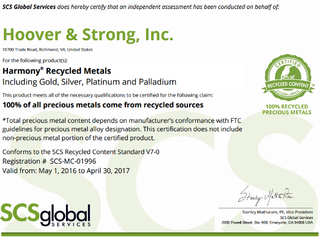
Our Stones
What are Salt & Pepper Diamonds?

Salt and Pepper diamonds are natural diamonds that have unique, black pepper like speckles. All diamonds are pure carbon. A white diamond is pure carbon and so to is a salt and pepper diamond. The black speckles present in a salt and pepper diamond are also pure carbon. Just like how freckles can form on the skin as a result of an overproduction of melanin, black speckles of carbon in a diamond simply didn't crystallize at the same rate as the rest of the atoms for one reason or another.Other diamond colors like orange, green, blue, etc. are attributed to other elements present in the diamond. Orange, for example, means the nitrogen atoms have grouped themselves in a very specific way. Green diamonds were exposed to some form of radiation during the stone's formation and journey to the Earth's surface. Rare blue diamonds are created when boron is captured in the structure. (Scientific American)
The natural black carbon inclusions do not inherently make the diamond weaker - A high quality salt and pepper diamond is the same strength as a white diamond and is every bit as durable.
With that being said, just like with all white diamonds there is a huge variety of quality among salt and pepper diamonds. The really low quality material will have a lot of surface pits that look like divots on the surface of the diamond along with cracks, etc that do affect the structural integrity of the diamond.
We have spent years identifying and cultivating relationships with diamond dealers who are committed to sourcing their salt and pepper diamonds ethically, and we are often the first to see any new conflict free salt and pepper diamonds that are available on the market. We have the largest collection of salt and pepper diamond engagement rings and salt and pepper diamonds in our loose stone section.
We look at hundreds of salt and pepper diamonds every month and only purchase a tiny percentage of what we see - we only purchase the most beautiful and interesting stones, with the best sparkle, and with little to no surface pits or structural issues. The diamonds that we pass on are then trickled down through the rest of the industry.
We inspect every diamond we buy under magnification with a microscope (the same microscope we use to set all of our melee diamonds for the most accurate, precise, and professional setting). Other high end jewelers who sell more of the 'cookie cutter' type rings will commonly use microscopes to inspect/set their diamonds as we do, but this practice is not common amongst our direct competitors who also sell salt and pepper diamonds. “It’s almost like when you look inside the diamond, you’re going on vacation to a special place." (Scientific American)
Diamonds are formed deep within the earth - about 100 miles or so below the surface. A combination of high temperature and high pressure is necessary for a diamond to form; the diamonds we see at the earth's surface are brought up from the mantle by a violent volcanic eruption. By moving quickly from the upper mantle to the surface of the earth (essentially moving rapidly from a high to a low temperature), the carbon atoms are locked in place into a diamond structure. (Smithsonianmag.com)
How We Select Our Salt and Pepper Diamonds
All of the diamonds we use are unique because they are cut by hand. Each stone is hand selected by a trained diamond expert that knows what attributes to look for as well as the stone setting ability of the diamond. Our stone requirements include:
- stone has little to no surface cracks and pits
- no surface reaching inclusions that effect the stone's structurally integrity
- symmetrically cut
- good translucency or opacity depending on the color of stone
Not all black, salt and pepper and icy white diamonds are equal, there is a huge range in quality. 90% of the salt and pepper diamonds available on the market have a lot of surface pits or cracks on the face of the stone or on the side girdle of the diamond. We are very selective and purchase only the highest quality stones.
The "4Cs"

Most people have heard of ‘the 4Cs’ when it comes to grading diamonds; color, clarity, cut, and carat. This scale is widely used across the engagement ring industry as an indicator of the ‘value’ of a diamond. Here at Point No Point Studio, we believe that the 4Cs, while important, shouldn’t be the only indicator of what is considered to be a beautiful diamond.
The value of the color, clarity, and cut of the diamond are all subjective to each individual; one bride may find a flawless clear brilliant cut diamond to be beautiful, while another favors a unique speckled rose cut diamond. The speckled diamond would be considered an ‘imperfect diamond’ according to the clarity scale, however beauty really is in the eye of the beholder.
Rose Cut
The rose cut diamond, so named because the facets are intended to look like an opening rose-bud, have a flat bottom with a domed top, which allows for a lower profile than a standard brilliant cut diamond with a taller culet.

Brilliant Cut

Although most of our designs feature rose cut diamonds, we do still have a soft spot for the more traditional brilliant cut diamond. Since we don't create many designs using brilliant cuts, you can rest assured that the ones we offer feature stunning diamonds that we just couldn't pass up.
Here at Point No Point Studio we pride ourselves on offering an array of alternative bridal options for brides who are searching for something more distinctive; although brilliant cut diamonds are one of the most widely used stones in the engagement ring market, we put our own twist on them by seeking out unique and stunning brilliant cuts (perhaps they feature an interesting inclusion, are more grey or salt & pepper in color, etc.)
Diamond Colors & Transparency
The diamonds that we work with can vary in color and translucency; here is a crash course to make sure we are speaking the same language.
Clear
This one is fairly self explanatory, but a clear diamond is a 'see through' diamond with no distinctive color to it. There may be slight inclusions to add character to the diamond, but we select diamonds with interesting inclusions that have no impact on the durability of the diamond.
Salt & Pepper (‘Speckled’)
Salt & Pepper (or ‘speckled’ diamonds) are mostly clear with white, grey, or black ‘salt & pepper’ like flecks. This style of diamond has become quite desirable in the last few years.
Translucent
A translucent diamond may be any color and may have selective inclusions, but you are able to see through most of or parts of the diamond.
Opaque
Opaque diamonds can be any color and can have many tones and depth to it, but it is not translucent or see through.
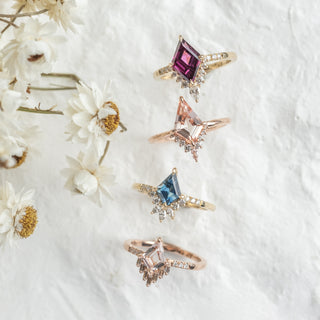
Gemstones
Gemstones make a great alternative to a diamond engagement ring. Our selection of gemstones has been carefully chosen for unique colors and unique shaped gemstones.
Gemstones that are unique in color and unique in shape are extremely rare. A very small percentage of gemstones is cut in a unique shape such as kite or hexagon. We can work with any type of gemstone. But only specific cuts are available for certain gemstone types. If you have something in mind reach out to us.
Durability
There is a reason that diamond has persisted for so long as the number one choice for an engagement ring, it is the most sparkly natural stone and also the hardest natural stone on earth. The hardness of a stone is what makes it durable. Diamonds rank as a number 10 on the Mohs Hardness Scale. Anything below a 10 should be carefully considered, that the wearer takes extra care with the stone. Gemstones can become abraded over time, meaning the face of the stone can become scratched just from daily wear.
Mohs Hardness Scale
(List of our most commonly requested stones)

